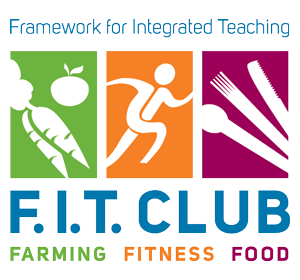Objective
Students will recognize what it means to eat a balanced diet.
Students will learn the suggested serving sizes for each food group.
Students will be able to place specific ingredients of certain meals on My Plate and identify whether the meal is balanced or not.
DOWNLOAD LESSON PLANS
-
What is a Balanced Diet Grades 1-3 – RI.2.7
FIT FAMILY books to read at home with parents and younger siblings
- The Food Parade by Elicia Castaldi
- I Will Not Ever Eat a Tomato by Lauren Child
- To Market, To Market by Anne Miranda
- Maisy Goes Shopping by Lucy Cousins
- Eating the Alphabet: Fruits and Vegetables from A to Z by Lois Ehlert
Intro to My Plate, What is a Balanced Diet?, Design a Day of Meals, and Let’s Stay Active! comprise the Core 4, and serve as an introduction to the F.I.T. Club Curriculum.
Consider sending home a letter explaining to parents that the class will be studying nutrition and exercise as a part of the next unit, since students will be examining components of healthy meals and developing personal exercise plans.
WEBSITE LINKS
- Choose My Plate
- Let’s Move!
- Staying Healthy @ KidsHealth.org
- American Academy of Pediatrics Healthy Living @ healthychildren.org
- Harvest Calendar for Rhode Island
- Sustainable Food Laboratory
- Wholesome Wave
- What’s In Season? at CookingLight.com
- Jamie Oliver’s Food Revolution
- PBS Kids Fizzy’s Lunch Lab
- CDC 2014 National Diabetes Statistics Report
- CDC Adult Obesity Facts and CDC Obesity Maps
- American College of Physicians Patient Brochures and Guidebooks
- IRA/NCTE Read Write Think
BOOKS AND ARTICLES
Nutrition
Butterworth, C. (2011). How Did that Get in my Lunchbox? The Story of Food. Somerville, MA: Candlewick Press.
Castaldi, E. (2013). The Food Parade: Healthy Eating with the Nutritious Food Groups. New York: Henry Holt and Company, LLC.
D’Amico, J., Drummond, K. (1999). The Healthy Body Cookbook: Over 50 Fun Activities and Delicious Recipes for Kids. San Francisco, CA: Jossey-Bass.
De Laurentiis, G. (2013). Recipe for Adventure Naples!. New York: Grosset and Dunlap.
- This series of books by the chef Giada De Laurentiis includes Paris!, Hong Kong!, and New Orleans!
Eamer, C. (2012). The World in Your Lunchbox: The Wacky History and Weird Science of Everyday Foods. Toronto, Ontario: Annick Press.
Integrated Marketing Services.(2012). Fresh Produce Guide: 300(+) Fruits, Vegetables and Herbs. Apopka, FL: Integrated Marketing Services.
Kessler, D. (2013). Your Food is Fooling You: How Your Brain is Hijacked by Sugar, Fat, and Salt. New York: Roaring Brook Press.
Macaulay, D. (2008). The Way We Work: Getting to Know the Amazing Human Body. Boston: Houghton Mifflin Company.
Leedy, L. (2007). The Edible Pyramid: Good Eating Every Day. New York: Holiday House.
Miller, E. (2008). The Monster Health Book: A Guide to Eating Healthy, Being Active & Feeling Great for Monsters & Kids! New York: Holiday House.
Reid, M., Reid, A. (2012). Portion Size Me: A Kid-Driven Plan to a Healthier Family. Naperville, IL: Sourcebooks.
Reference:
Brown, S. with Vaughan, C. (2009). Play: How it Shapes the Brain, Opens the Imagination, and Invigorates the Soul. New York: Avery.
Lehr, S. (1991). The Child’s Sense of Developing Theme: Responses to Literature. New York: Teachers College Press.
Louv, R. (2008). Last Child in the Woods: Saving Our Children from Nature-Deficit Disorder. Chapel Hill, NC: Algonquin Books of Chapel Hill.
Obama, M. (2012). American Grown: The Story of the White House Kitchen Garden and Gardens Across America. New York: Crown.
Oliver, J. (2008). Jamie’s Food Revolution: Rediscover How to Cook Simple, Delicious, Affordable Meals. New York: Hyperion.
Pappas, C., Kiefer, B., and Levstik, L. (1999). An Integrated Language Perspective in the Elementary School: An Action Approach, Third Edition. New York: Addison Wesley Longman, Inc.
Pollan, M. (2013). Cooked: A Natural History of Transformation. New York: The Penguin Press.
